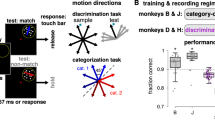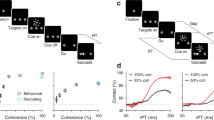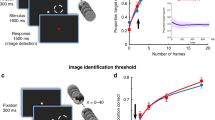Abstract
This study aimed to identify neural mechanisms that underlie perceptual learning in a visual-discrimination task. We trained two monkeys (Macaca mulatta) to determine the direction of visual motion while we recorded from their middle temporal area (MT), which in trained monkeys represents motion information that is used to solve the task, and lateral intraparietal area (LIP), which represents the transformation of motion information into a saccadic choice. During training, improved behavioral sensitivity to weak motion signals was accompanied by changes in motion-driven responses of neurons in LIP, but not in MT. The time course and magnitude of the changes in LIP correlated with the changes in behavioral sensitivity throughout training. Thus, for this task, perceptual learning does not appear to involve improvements in how sensory information is represented in the brain, but rather how the sensory representation is interpreted to form the decision that guides behavior.
This is a preview of subscription content, access via your institution
Access options
Subscribe to this journal
Receive 12 print issues and online access
$209.00 per year
only $17.42 per issue
Buy this article
- Purchase on Springer Link
- Instant access to full article PDF
Prices may be subject to local taxes which are calculated during checkout







Similar content being viewed by others
References
Goldstone, R.L. Perceptual learning. Annu. Rev. Psychol. 49, 585–612 (1998).
Karni, A. & Sagi, D. Where practice makes perfect in texture discrimination: evidence for primary visual cortex plasticity. Proc. Natl. Acad. Sci. USA 88, 4966–4970 (1991).
Mollon, J.D. & Danilova, M.V. Three remarks on perceptual learning. Spat. Vis. 10, 51–58 (1996).
Dosher, B.A. & Lu, Z.L. Mechanisms of perceptual learning. Vision Res. 39, 3197–3221 (1999).
Recanzone, G.H., Schreiner, C.E. & Merzenich, M.M. Plasticity in the frequency representation of primary auditory cortex following discrimination training in adult owl monkeys. J. Neurosci. 13, 87–103 (1993).
Recanzone, G.H., Merzenich, M.M., Jenkins, W.M., Grajski, K.A. & Dinse, H.R. Topographic reorganization of the hand representation in cortical area 3b owl monkeys trained in a frequency-discrimination task. J. Neurophysiol. 67, 1031–1056 (1992).
Schoups, A., Vogels, R., Qian, N. & Orban, G. Practicing orientation identification improves orientation coding in V1 neurons. Nature 412, 549–553 (2001).
Crist, R.E., Li, W. & Gilbert, C.D. Learning to see: experience and attention in primary visual cortex. Nat. Neurosci. 4, 519–525 (2001).
Ghose, G.M., Yang, T. & Maunsell, J.H. Physiological correlates of perceptual learning in monkey V1 and V2. J. Neurophysiol. 87, 1867–1888 (2002).
Yang, T. & Maunsell, J.H. The effect of perceptual learning on neuronal responses in monkey visual area V4. J. Neurosci. 24, 1617–1626 (2004).
Raiguel, S., Vogels, R., Mysore, S.G. & Orban, G.A. Learning to see the difference specifically alters the most informative V4 neurons. J. Neurosci. 26, 6589–6602 (2006).
Ahissar, M. & Hochstein, S. Attentional control of early perceptual learning. Proc. Natl. Acad. Sci. USA 90, 5718–5722 (1993).
Saarinen, J. & Levi, D.M. Perceptual learning in vernier acuity: what is learned? Vision Res. 35, 519–527 (1995).
Li, W., Piech, V. & Gilbert, C.D. Perceptual learning and top-down influences in primary visual cortex. Nat. Neurosci. 7, 651–657 (2004).
Maunsell, J.H. & Van Essen, D.C. Functional properties of neurons in middle temporal visual area of the macaque monkey. I. Selectivity for stimulus direction, speed, and orientation. J. Neurophysiol. 49, 1127–1147 (1983).
Britten, K.H., Shadlen, M.N., Newsome, W.T. & Movshon, J.A. The analysis of visual motion: a comparison of neuronal and psychophysical performance. J. Neurosci. 12, 4745–4765 (1992).
Britten, K.H., Newsome, W.T., Shadlen, M.N., Celebrini, S. & Movshon, J.A. A relationship between behavioral choice and the visual responses of neurons in macaque MT. Vis. Neurosci. 13, 87–100 (1996).
Newsome, W.T. & Pare, E.B. A selective impairment of motion perception following lesions of the middle temporal visual area (MT). J. Neurosci. 8, 2201–2211 (1988).
Salzman, C.D., Britten, K.H. & Newsome, W.T. Cortical microstimulation influences perceptual judgments of motion direction. Nature 346, 174–177 (1990).
Colby, C.L. & Goldberg, M.E. Space and attention in parietal cortex. Annu. Rev. Neurosci. 22, 319–349 (1999).
Platt, M.L. & Glimcher, P.W. Neural correlates of decision variables in parietal cortex. Nature 400, 233–238 (1999).
Snyder, L.H., Batista, A.P. & Andersen, R.A. Intention-related activity in the posterior parietal cortex: a review. Vision Res. 40, 1433–1441 (2000).
Gold, J.I. & Shadlen, M.N. The neural basis of decision making. Annu. Rev. Neurosci. 30, 535–574 (2007).
Shadlen, M.N. & Newsome, W.T. Neural basis of a perceptual decision in the parietal cortex (area LIP) of the rhesus monkey. J. Neurophysiol. 86, 1916–1936 (2001).
Roitman, J.D. & Shadlen, M.N. Response of neurons in the lateral intraparietal area during a combined visual discrimination reaction time task. J. Neurosci. 22, 9475–9489 (2002).
Hanks, T.D., Ditterich, J. & Shadlen, M.N. Microstimulation of macaque area LIP affects decision-making in a motion discrimination task. Nat. Neurosci. 9, 682–689 (2006).
Horwitz, G.D. & Newsome, W.T. Separate signals for target selection and movement specification in the superior colliculus. Science 284, 1158–1161 (1999).
Kim, J.N. & Shadlen, M.N. Neural correlates of a decision in the dorsolateral prefrontal cortex of the macaque. Nat. Neurosci. 2, 176–185 (1999).
Gold, J.I. & Shadlen, M.N. The influence of behavioral context on the representation of a perceptual decision in developing oculomotor commands. J. Neurosci. 23, 632–651 (2003).
Zohary, E., Celebrini, S., Britten, K.H. & Newsome, W.T. Neuronal plasticity that underlies improvement in perceptual performance. Science 263, 1289–1292 (1994).
Shadlen, M.N., Britten, K.H., Newsome, W.T. & Movshon, J.A. A computational analysis of the relationship between neuronal and behavioral responses to visual motion. J. Neurosci. 16, 1486–1510 (1996).
Eckhoff, P., Holmes, P., Law, C., Connolly, P.M. & Gold, J.I. On diffusion processes with variable drift rates as models for decision making during learning. New J. Phys. 10, 015006 (2007); doi:10.1088/1367-2630/10/1/015006.
Ball, K. & Sekuler, R. A specific and enduring improvement in visual motion discrimination. Science 218, 697–698 (1982).
Liu, Z. & Weinshall, D. Mechanisms of generalization in perceptual learning. Vision Res. 40, 97–109 (2000).
Movshon, J.A. & Newsome, W.T. Visual response properties of striate cortical neurons projecting to area MT in macaque monkeys. J. Neurosci. 16, 7733–7741 (1996).
Furmanski, C.S., Schluppeck, D. & Engel, S.A. Learning strengthens the response of primary visual cortex to simple patterns. Curr. Biol. 14, 573–578 (2004).
Pleger, B. et al. Functional imaging of perceptual learning in human primary and secondary somatosensory cortex. Neuron 40, 643–653 (2003).
Bao, S., Chang, E.F., Woods, J. & Merzenich, M.M. Temporal plasticity in the primary auditory cortex induced by operant perceptual learning. Nat. Neurosci. 7, 974–981 (2004).
Blake, D.T., Heiser, M.A., Caywood, M. & Merzenich, M.M. Experience-dependent adult cortical plasticity requires cognitive association between sensation and reward. Neuron 52, 371–381 (2006).
Celebrini, S. & Newsome, W.T. Neuronal and psychophysical sensitivity to motion signals in extrastriate area MST of the macaque monkey. J. Neurosci. 14, 4109–4124 (1994).
Freedman, D.J. & Assad, J.A. Experience-dependent representation of visual categories in parietal cortex. Nature 443, 85–88 (2006).
Grunewald, A., Linden, J.F. & Andersen, R.A. Responses to auditory stimuli in macaque lateral intraparietal area. I. Effects of training. J. Neurophysiol. 82, 330–342 (1999).
Hall, G. Perceptual and Associative Learning (Oxford University Press, Oxford, 1991).
Lewis, J.W. & Van Essen, D.C. Corticocortical connections of visual, sensorimotor, and multimodal processing areas in the parietal lobe of the macaque monkey. J. Comp. Neurol. 428, 112–137 (2000).
Seidemann, E. & Newsome, W.T. Effect of spatial attention on the responses of area MT neurons. J. Neurophysiol. 81, 1783–1794 (1999).
Sereno, A.B. & Amador, S.C. Attention and memory-related responses of neurons in the lateral intraparietal area during spatial and shape-delayed match-to-sample tasks. J. Neurophysiol. 95, 1078–1098 (2006).
Vaina, L.M., Belliveau, J.W., des Roziers, E.B. & Zeffiro, T.A. Neural systems underlying learning and representation of global motion. Proc. Natl. Acad. Sci. USA 95, 12657–12662 (1998).
Fine, I. & Jacobs, R.A. Comparing perceptual learning tasks: a review. J. Vis. 2, 190–203 (2002).
Cox, R.W. AFNI: software for analysis and visualization of functional magnetic resonance neuroimages. Comput. Biomed. Res. 29, 162–173 (1996).
Van Essen, D.C. Organization of visual areas in macaque and human cerebral cortex. in The Visual Neurosciences (eds. Chalupa, L. & Werner, J.S.) 507–521 (MIT Press, Cambridge, Massachusetts, 2004).
Acknowledgements
We thank M. Shadlen, L. Ding, M. Nassar, B. Heasley, R. Kalwani, P. Connolly, C.-L. Teng and S. Bennur for helpful comments on this manuscript and J. Zweigle for expert technical assistance. This research was supported by the Sloan Foundation, the McKnight Foundation, the Burroughs-Wellcome Fund and the US National Institutes of Health (R01-EY015260 and T32-EY007035).
Author information
Authors and Affiliations
Contributions
J.I.G. planned and supervised the study. C.L. conducted the experiments and data analyses. C.L. and J.I.G. wrote the manuscript together.
Corresponding author
Supplementary information
Supplementary Text and Figures
Supplementary Figures 1–5 and Table 1 (PDF 7828 kb)
Rights and permissions
About this article
Cite this article
Law, CT., Gold, J. Neural correlates of perceptual learning in a sensory-motor, but not a sensory, cortical area. Nat Neurosci 11, 505–513 (2008). https://doi.org/10.1038/nn2070
Received:
Accepted:
Published:
Issue Date:
DOI: https://doi.org/10.1038/nn2070
This article is cited by
-
Decision-making processes in perceptual learning depend on effectors
Scientific Reports (2024)
-
Category representation in primary visual cortex after visual perceptual learning
Cognitive Neurodynamics (2024)
-
Neural ensembles in the murine medial prefrontal cortex process distinct information during visual perceptual learning
BMC Biology (2023)
-
Low-dimensional encoding of decisions in parietal cortex reflects long-term training history
Nature Communications (2023)
-
Current directions in visual perceptual learning
Nature Reviews Psychology (2022)



